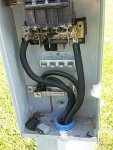I agree with Mivey on the "pushing down" of the pedestal causing the right-hand short black conductor to be pulled on, developing the force to yank on the right-hand lug. And, when the pedestal was subsequently pushed back into a vertical position, the black conductor pushes back into the position seen, establishing enough of a simple pressure connection to handle the load to the extent that it could. And, since you, 480, got a trouble call from the occupant, the pressure connection was not stable.
Your observation that the pedestal being pushed over more than once would lead me to suspect that the back-and-forth pushing of the service lateral conductor (the black right-hand) would shove the lug out of the way.
I see this all the time in service raceway masts, that get pulled off a building wall by storm-tree-damage coming down on the overhead service drop, and where the mast breaks at the raceway connector at the top of the meter socket. Even when the hinge point at the break in the raceway-to-meter socket connector doesn't break apart, that is, it only hinges, the yank on the service conductors having to be longer than they are, pulls on the meter socket lugs doing all sorts of different types of damage to the meter socket lugs and insulator mounts.
The fascinating thing, to me, is that all this observable damage that we see in the photo happened with a minimum of any welding-level arcing . . .




